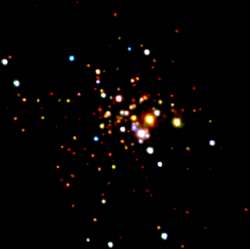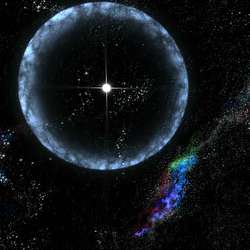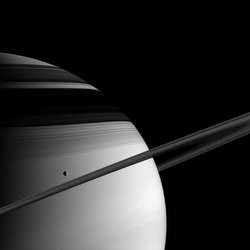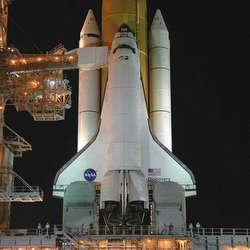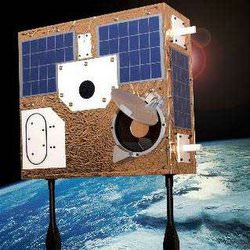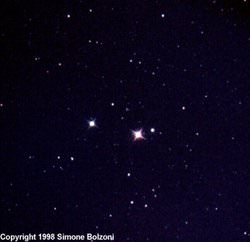
Omicron Cygni. Image credit: Simone Bolzoni. Click to enlarge.
Monday, July 18 – Twenty five years ago today, India launched its first satellite. Tonight about 45 minutes after sunset, watch as Venus and Regulus begin their dance over the week. Tonight the pair will appear about half a fist apart, with Regulus to the south (left) and slightly east (above) sparkling Venus. While magnitude 1 Regulus is the brightest star in Leo, you may initially need binoculars to pick it out of the bright twilight. Be sure to monitor the pair each night as they make their closest appearance on Friday.
While the Moon will dominate tonight’s sky, we can still take a very unusual and beautiful journey to a bright and very colorful pair of stars known as Omicron 1 Cygni. Easily located about halfway between Alpha (Deneb) and Delta on the western side, this is a pure delight in binoculars or any size telescope. The striking gold color of 3.7 magnitude 31 Cygni (Omicron 1) is easily highlighted against the blue of same field companion, 5th magnitude 30 Cygni. Although this wide pairing is only an optical one, the K-type giant is a double star – an eclipsing variable around 150 times larger than or own Sun – and is surrounded by a gaseous corona more than double the size as the star itself. If you are using a scope, you can easy spot the blue tinted, 7th magnitude B star about one third the distance as between the two giants. Although our true pair are some 1.2 billion miles apart, they are oriented nearly edge-on from our point of view – allowing the smaller star to be totally eclipsed during each revolution. This total eclipse lasts for 63 days and happens about every 10.4 years, but don’t stay up too late… We’ve still got 7 years to wait!
Tuesday, July 19 – Today in 1846, Edward Pickering was born. Although his name is not well known, he became a pioneer in the field of spectroscopy. Pickering was the Harvard College Observatory Director from 1876 to 1919, and it was during his time there that photography and astronomy began to merge. Known as the Harvard Plate Collection, these archived beginnings still remain a valuable source of data.
Tonight bright, fat Selene will hold court directing in the middle of the constellation of Saggitarius. Can you still make out the “teapot” pattern? The tip of the “spout” – Al Nasl – will be a little less than a fist width to the Moon’s northwest and the top of the “lid” – Kaus Borealis will be half a fist above it. Can you see than “handle” a half a fist away to the east? For viewers in most of Australia, you will have the chance to see the Moon occult 3.3 magnitude Tau and you will find locations and times on this IOTA webpage.
Wednesday, July 20 – Today is a busy day in astronomy history! In 1969, the world held its breath as the Apollo 11 lander touched down and Neil Armstong and Edwin Aldrin became the first humans to touch the lunar surface. We celebrate our very humanity because even Armstrong was so moved that he messed up his lines! The famous words were meant to be “A small step for a man. A giant leap for mankind.” That’s nothing more than one small error for a man, and mankind’s success continued on July 20, 1976 when Viking 1 landed on Mars – sending back the first images ever taken from that planet’s surface.
For most of us, tonight the Moon will be about as full as it’s going to get, but it is great fun just to trace its bright ray systems. In the northeast quarter, look for a faded ray which cuts its way diagonally from Menelaus, across Mare Crisium and all the way to Atlas and Hercules. Notice how bright the ejecta blankets around Copernicus, Keplar and Aristarchus are. Who cannot be amazed at Tycho and its broad system that covers the entire southern region?
Thursday, July 21 – The Moon will become officially full at 11:00 UT. Sometimes known as the Summer Moon or Thunder Moon, at 20:00 UT, it will reach perigee and the second closest Earth-Moon separation of the year.
With only a short time until Luna rises tonight, let’s take a look at a pair of stars who also have a close separation – Epsilon Lyrae. Known to most of us as the “Double Double”, look about a finger width northeast of Vega. Even the slightest optical aid will reveal this tiny star as a pair, but the real treat is with a telescope – for both components are double stars! Both sets of stars appear as primarily white and both are very close to each other in magnitude. What is the lowest power that you can use to split them?
Friday, July 22 – Be sure to watch the western horizon about 45 minutes after sunset to catch Venus dancing by Regulus tonight. Just barely more than a degree (a finger width) separates the two pair, with the stately star having moved west (below) and slightly south (left) of the bright planet. If you continue your observations, you will note the pair continues to move apart about a degree a day until Regulus is lost.
Tonight we will note the work of Friedrich Bessel, who was born on this day in 1784. Bessel was a German astronomer and mathematician whose functions still carry his name in many areas of mathematical physics. But, you may put away your calculator, because Bessel was also the very first person to measure a star’s parallax. In 1837, he chose 61 Cygni and the measurement was no more than a third of an arc second. His work ended a debate that had stretched back two millenia to Aristotle’s time and the Greek’s theories about the distances to the stars.
With the slightly later rise of the Moon, this would be a great evening to check out 61 Cygni for yourself. Like finding Omicron earlier in the week, you’ll easily locate 61 between Deneb and Zeta on the eastern side. Look for a small trio of just visible stars and choose the westernmost. Not only is it famous because of Bessel’s work, but it is one of the most noteworthy of double stars for a small telescope. Of the unaided visible stars in the constellation of Cygnus, 61 is the fourth closest star to Earth, with only Alpha Centauri, Sirius, and Epsilon Eridani closer. Just how close is it? Try right around 11 light years.
Visually, the two components have a slightly orange tint, are less than a magnitude apart in brightness and a nice separation of around 30″ to the south/southeast. Back in 1792, Piazzi first noticed its abnormally large proper motion and dubbed it “The Flying Star”. At that time, it was only separated by around 10″ and the B star was to the northeast. It takes nearly 7 centuries for the pair to orbit each other, but there is another curiosity here. Orbiting the A star around every 4.8 years is an unseen body that is believed to be about 8 times larger than Jupiter. A star – or a planet? With a mass considerably smaller than any known star, chances are good that when you view 61 Cygni, you’re looking toward a distant world!
If you are up late enough tonight, you can also see the lunar crater named for Bessel as a small, bright ring located just slightly southwest of the center of Mare Crisium.
Saturday, July 23 – Tonight we have awhile to enjoy early dark skies, so let’s head toward an outstanding globular cluster that can be seen in anything from small binoculars to a huge telescope. It’s as easy as finding Antares, so slide 1.3 degrees west and behold the M4.
To binoculars, this huge, very loose globular cluster will look much like a “gone to seed” dandelion with its soft, white round form – yet even the smallest of telescopes can begin to resolve out individual stars in this 5700 light year distant system. As you step up in aperture, you step up in resolution and individual chains and bars of stars begin to swim forward from its more than 10,000 members. Enjoy it tonight!
Sunday, July 24 – If you have the chance to arise before dawn, be sure to look for Mars about halfway up the southeast skies. Now cruising through Pices at around a half a degree a day, most observers will see 4th magnitude Omicron about a finger width above the Red Planet this morning. Just as we’ve watched the motions of Saturn, Venus and Mercury over the last few weeks, use this star to judge Mars’ motion over the next few mornings. Which way is it heading?
Tonight let’s just enjoy a little stargazing and revel in the beauty of our own galaxy’s spiral arm – the Milky Way. For those living in the city, you owe it to yourself to get away to a dark location to enjoy this veritable “river of stars” which spans out of the galactic center south and runs overhead. Almost directly behind you from the galactic anti-center stretches the Perseus arm, and the sight is a beautiful one. If skies are fine, you can easily see the dark dust rift where the arm separates and the billows of light of unresolved stars. It’s the most glorious sight of summer! While we have many days yet before the Aquarid meteor shower officially reaches its peak, you will be pleasantly surprised at this year’s high activity. They’ve been flying out of the night sky for almost two weeks now, and it would not surprise me if you saw ten or more per hour of these quick, bright visitors.
In the mean time? Ask for the Moon, but keep reaching for the stars! May all your journeys be at Light Speed… ~Tammy Plotner

